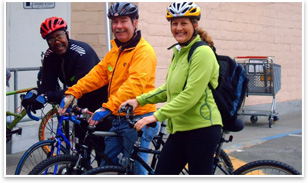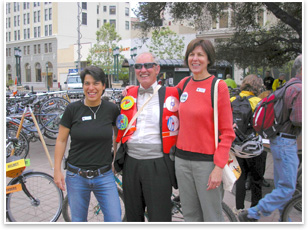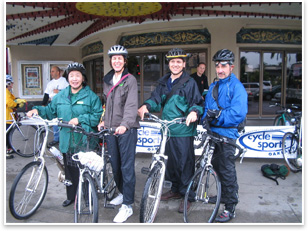
| “Bike to Work Day” Can Teach Livable, Green Design
How Do You . . . use “Bike to Work Day” in your own community? Summary: “Bike to Work Day” will take place on May 17 in the San Francisco Bay Area and May 16 and 18 in other parts of the country. The day-long event is part of “Bike to Work, School, Errands, or Play Week” and “Bike Month.” The goal of the nationwide event is to spotlight human transportation, encourage governments to provide infrastructure for bicycling, and increase awareness about global warming, congestion, and unsafe streets. Ron Bishop, AIA, East Bay, Calif., believes AIA members can learn livable, green design strategies by participating in the event.
Including bicycling in infrastructure
Bishop, who maintains that biking improves the health of the individual, the community, and reduces CO2 emissions, believes the problem is the lack of infrastructure design for bikes. “When good street design is employed, cycling increases. More riders draw even more riders. But even though we design housing and shopping, we’re not providing any way to get there other than driving.” Bishop suggests that well-marked bike lanes be placed on roadways. “If you don’t have bike lanes, motorists and cyclists are not sure what to do.”
Community infrastructure designs, Bishop maintains, need to include bike parking at places like transit centers. “An infrastructure with bike parking costs less, will be more energy efficient, have less pollution, encourage more cyclists, and provide a better use of space.” Bishop provides an example: “We have bike stations within the Bay Area Rapid Transit where you give your bicycle to a parking attendant. They even do repairs, checking your tires and aligning your wheels. And it’s free.”
Bishop emphasizes that bikeable cities must become more than words. “Architects need to step up, make it a reality . . . embrace human transport through bikeability and walkability. Global warming, congestion, and unsafe streets shouldn’t be tolerated.” |
||
Copyright 2007 The American Institute of Architects. All rights reserved. Home Page |
||
home
news headlines
practice
business
design
recent related
› What Makes a Community Livable? (PDF)
› EPA Lauds Five Smart Growth Projects
To learn the date of Bike to Work Day in your city and what you can do to participate, go to The League of American Bicyclists Web site.
Captions
1: TK
2:
3. Left to right: Councilwoman Jean Quan; Councilwoman Pat Kernighan; City Staff Zac Wald.
4. TK
Fun “Bike to Work” sites also include:
• California
• San Francisco Bay area
• Washington, D.C.
Did you know . . .
Last year, Bike to Work Day was held in 33 states and Washington D.C.
• Bay Area politicians participate in Bike to Work Day in pedal pools led by qualified cyclists. The pedal pools consist of constituents and politicians who ride in from various districts and meet at City Hall in Oakland for a traditional pancake breakfast.
• Hundreds of energizer stations throughout California on Bike to Work Day allow cyclists to stop for refreshments.
• Ron Bishop offers tips for architects who become bicyclists: “A well-equipped bicycle has lights, a bell, fenders, and a rack. This allows travel in inclement weather and increases the carrying capacity without encumbering the cyclist. A well-attired cyclist has a helmet, bright clothing—yellow or ‘screaming’ green—gloves, and glasses.”
• Congressman Earl Blumenauer (D-Ore.), a champion of AIA causes in Congress, is well known for his habit of biking to work from his Capitol Hill home.

 “Bike to Work Day” expects 30,000-40,000 bicyclists in the Bay Area alone. The event is sponsored by the San Francisco Bicycle Coalition. Nationwide “Bike Days” are planned to coincide with National Transportation Week, May 13–19, and “Bike Month.”
“Bike to Work Day” expects 30,000-40,000 bicyclists in the Bay Area alone. The event is sponsored by the San Francisco Bicycle Coalition. Nationwide “Bike Days” are planned to coincide with National Transportation Week, May 13–19, and “Bike Month.”  And architects can learn from the experience. For example, in Oakland, 85 percent of the trips are less than 2 miles. In fact, across America, 40 percent of all trips are less than 2 miles, Bishop contends, asking: “So why are we only accommodating motor vehicles? . . . The AIA is on board with Transit Oriented Design Development (TODD) and can do more to improve the viability of transit to help create walkable, bikeable, livable cities. Biking is often talked about as an important factor, but the idea of bike lanes and bike parking is seldom included in TODD projects.”
And architects can learn from the experience. For example, in Oakland, 85 percent of the trips are less than 2 miles. In fact, across America, 40 percent of all trips are less than 2 miles, Bishop contends, asking: “So why are we only accommodating motor vehicles? . . . The AIA is on board with Transit Oriented Design Development (TODD) and can do more to improve the viability of transit to help create walkable, bikeable, livable cities. Biking is often talked about as an important factor, but the idea of bike lanes and bike parking is seldom included in TODD projects.” Bishop says the key is for architects to become more political about transportation issues. “We’re building cities—and that includes transportation—but we’re not participating in the parking because someone else determined what people are driving. Architects need to encourage governments to provide better infrastructure for bicycle travel.”
Bishop says the key is for architects to become more political about transportation issues. “We’re building cities—and that includes transportation—but we’re not participating in the parking because someone else determined what people are driving. Architects need to encourage governments to provide better infrastructure for bicycle travel.” Positive impact; architects can help
Positive impact; architects can help